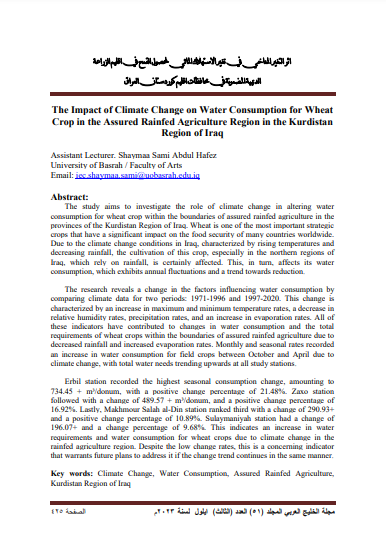The Impact of Climate Change on Water Consumption for Wheat Crop in the Assured Rainfed Agriculture Region in the Kurdistan Region of Iraq
Keywords:
Climate Change, Water Consumption, Assured Rainfed Agriculture, Kurdistan Region of IraqAbstract
The study aims to investigate the role of climate change in altering water consumption for wheat crop within the boundaries of assured rainfed agriculture in the provinces of the Kurdistan Region of Iraq. Wheat is one of the most important strategic crops that have a significant impact on the food security of many countries worldwide. Due to the climate change conditions in Iraq, characterized by rising temperatures and decreasing rainfall, the cultivation of this crop, especially in the northern regions of Iraq, which rely on rainfall, is certainly affected. This, in turn, affects its water consumption, which exhibits annual fluctuations and a trend towards reduction.
The research reveals a change in the factors influencing water consumption by comparing climate data for two periods: 1971-1996 and 1997-2020. This change is characterized by an increase in maximum and minimum temperature rates, a decrease in relative humidity rates, precipitation rates, and an increase in evaporation rates. All of these indicators have contributed to changes in water consumption and the total requirements of wheat crops within the boundaries of assured rainfed agriculture due to decreased rainfall and increased evaporation rates. Monthly and seasonal rates recorded an increase in water consumption for field crops between October and April due to climate change, with total water needs trending upwards at all study stations.
Erbil station recorded the highest seasonal consumption change, amounting to 734.45 + m³/donum, with a positive change percentage of 21.48%. Zaxo station followed with a change of 489.57 + m³/donum, and a positive change percentage of 16.92%. Lastly, Makhmour Salah al-Din station ranked third with a change of 290.93+ and a positive change percentage of 10.89%. Sulaymaniyah station had a change of 196.07+ and a change percentage of 9.68%. This indicates an increase in water requirements and water consumption for wheat crops due to climate change in the rainfed agriculture region. Despite the low change rates, this is a concerning indicator that warrants future plans to address it if the change trend continues in the same manner.




